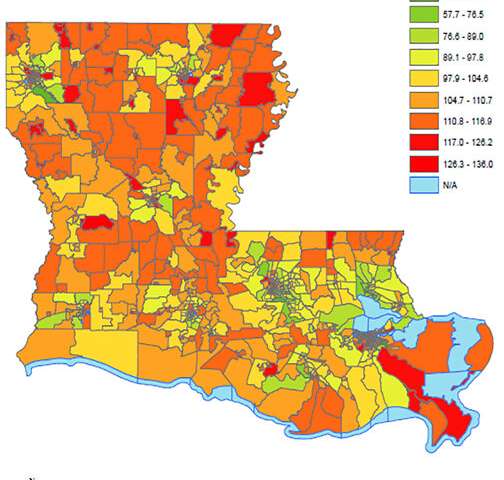
A study by researchers at LSU Health New Orleans School of Public Health, believed to be the first study to investigate the role of neighborhood deprivation on COVID-19 in Louisiana, found that the more a neighborhood is deprived, the higher the risk for cases of COVID-19. They report that people living in the most deprived neighborhoods had an almost 40% higher risk of COVID-19 compared to those residing in the least deprived neighborhoods. Their findings are published online in PLOS ONE, available here.
Led by Edward S. Peters, DMD, SM, ScD, FACE, the team at LSU Health New Orleans School of Public Health sought to find more definitive answers about what contributed to the nation’s highest per capita rate of COVID-19 cases in New Orleans during the summer of 2020 and the disproportionate number of African Americans affected. Few studies in the US had assessed the role of social determinants of health on COVID-19 disease. The studies that existed examined only a couple of specific risk factors, such as overcrowding and income. The LSU Health New Orleans team took a much more comprehensive approach to examine the relationship between neighborhood deprivation and COVID-19 in Louisiana.
The authors explain, “Risk factors leading to COVID-19 disease, hospitalization, and mortality exist not only at the individual or biological level; neighborhood-level factors and their interactions with individual-level factors are also responsible for the observed disparities. Lack of access to health care, unemployment, less education, and poor housing conditions significantly increase the risk of COVID-19 infection. These determinants of health can be studied collectively as neighborhood or area deprivation.”
“We used a measurement called the Area Deprivation Index (ADI) to look at how relative deprivation of Louisiana neighborhoods is associated with the rate of COVID-19 cases,” notes Dr. Peters, Professor and Chair of Epidemiology at LSU Health New Orleans School of Public Health. “The ADI uses 17 census-derived measures of poverty, education, housing, and employment indicators at the census tract level to classify neighborhoods. It is a robust metric measuring many relevant social determinants of health that may help explain the socio-biologic mechanisms of disease. We obtained the cumulative number of Louisiana COVID-19 case counts from the Louisiana Department of Health on July 31, 2020. We estimated COVID-19 risk for five categories of deprivation, ranging from least to most deprived neighborhoods.”
The authors noted that non-Hispanic African Americans are more likely to have vulnerable and low-paying jobs that do not allow remote work, are more likely to rely on public transportation and to live in crowded housing or work in crowded worksites that place them an increased risk for COVID-19. African Americans exhibit a greater burden of chronic medical conditions such as hypertension, diabetes, heart disease, chronic disease, and obesity that increase the severity of COVID-19 illness. In Louisiana, 2.9 million people have at least one chronic condition, and 68% of Louisiana adults are overweight or obese. Furthermore, the poverty rate is much higher among African Americans compared to Non-Hispanic Whites, and African Americans tend to live in neighborhoods with high poverty. Neighborhood socioeconomic status is linked to access to health care services, and people residing in low socioeconomic status neighborhoods are less likely to have access to health care services, which further increases the risk of adverse health outcomes related to COVID-19, such as a higher rate of hospitalizations and mortality.
“We observed a great disparity in deprivation among Louisiana neighborhoods,” Peters says. “We also found an association between neighborhood deprivation and cumulative COVID-19 cases per 1,000 persons in Louisiana. Neighborhoods with greater deprivation should be especially targeted with public health prevention measures such as wearing a mask while in public, social distancing, and considered as a priority for COVID-19 vaccine delivery.”
Source: Read Full Article
